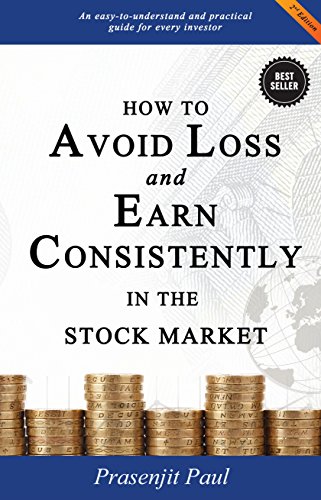
ISBN: 9352679717 PaperBack
ASIN: B076MKJV6Y Kindle
Who is the book for: The book is meant for retail investors with a long term investment horizon.
What retail investors must avoid to avoid losing money?
(1) Following the stock tips provided by brokers blindly. Brokers have vested interests in increasing volume of your trade and not your profits.
(2) Intraday Trading : Its a high speed game which hardly anyone has mastered. Its no wonder we don’t have any stock market millionaires/billionaires who have become rich solely due to intra day trading.
(3) Investing on Borrowed Money: Although stock market is one of the greatest wealth generators it comes with no guarantees or timelines. Pressure of borrowed money and to make higher returns than the cost of funds can cause the investors to take many high risk bets leading to loss of capital.
(4) F&O trading: High margin trading without understanding its risk can cause capital to be wiped out in no time.
The time tested strategy to create wealth in the stock market is to:
“Invest in high quality business(stocks) and hold it for the long run.”
What to Expect from the market?
- 20 – 25% returns annually. A return atleast double the FD and positive returns considering inflation and taxes.
- Learn before you Earn. Investment in Knowledge provides the best returns.

Retail Investor Misconceptions that lead to low returns:
Myth #1 Low priced stocks are cheap and high priced are expensive.
Reality #1 It is possible for a stock priced at Rs.2000 to be cheaper than a stock priced at Rs.2.
Myth #2 Investing in Low PE stocks is called Value Investing.
Reality #2 Valuation is based on multiple parameters. P/E is a function of Growth, Business model , Industry, Market positioning etc. P/E is not a standalone metric.
Myth #3 52 week high stocks are overvalued and 52 week Low stocks are undervalued.
Reality #3 Stock prices are dictated by changing fundamentals. So considering prices solely to determine valuation is flawed.
Myth #4 Stocks that have already doubled have less scope to go up further.
Reality #4 If fundamentals support a growth stock may move up further.
Myth #5 Stocks that fall sharply must rise sharply.
Reality #5 It may fall further if fundamentals had deteriorated.
Myth #6 Large caps are safer than small caps.
Reality #6 Quality small caps can more resilient than large caps during a fall
Portfolio Management
-> Do not profile stocks based on Market cap alone
-> Do not invest in too many stocks. A 10 stock portfolio may be more diversified than a 40 stock portfolio when chosen carefully. i.e from sufficiently diverse sectors.
Rest of the post is going to be ripe with Jargons. In financial education, this is something you will have to eventualy learn. I have linked up all the terms to corresponding articles in Investopedia. Please do check them out for better understanding.
Metrics to be used for valuation
(1) P/E ratio is the most popular metric. However it is not to be used standalone. Comparison with historical Average, peer comparison, broader market to be used to value the current P/E.
(2) P/S ratio can be used for cyclicals eg: Agri input companies or with one time profit/loss impacts or turnarounds Eg: Arcelor-Mittal.
(3) P/B ratio – Banking stocks Eg: SBI or capital intensive Eg: Power projects
Filtration Criteria to find undervalued stocks using PEG ratio:
PEG ratio is one of the favorite valuation tools of legendery Investor Peter Lynch.
If PE and P/B is less than 5 years average, PEG <0.5 – Undervalued – BEST Investment Opportunity
If PE and P/B is about average, PEG <= 1. Research other parameters and invest – Mediocre Opportunity
PEG = 1- 2 – Hold. Don’t make fresh investments.
PEG > 2 Overvalued. Sell
Check Price Action to avoid Value Traps
(1) If last 3 years and last 1 year annualised return is negative – Avoid
(2) If last 3 years annualized return <10 % – Could be a value trap. Approach with caution
(3) If last 1 year and last 3 years return > 10% – then consider.
Quick 2 Minute Check before Investing:
ROE and ROCE >20% for the last 3 years
Debt to Equity < 1
Promoter’s Pledging < 10%
Compounded Annual Growth Rate (CAGR) Sales > 10%
Compounded Annual Growth Rate CAGR Profit > 12%
PE < 2(Avg EPS growth of last 3 years)
Above valuation is not applicable for Banking and NBFC’s. Parameters to consider for such companies are :
Non Performing Assets (NPA)
Net Interest Margin (NIM)
When to Sell
This is a more difficult question than when to buy.
(1) Better Opportunities
(2) Buying decision was wrong Eg: New info about any malpractices has been exposed like PC Jewellers
(3) Valuation is overstretched
(4) Change in Fundamentals
(5) Change in Management
(6) Pre-defined exit strategy Eg: Oil companies bought with expectation of a favourabel movt in oil prices. Exit when move is complete.
Don’t repent after selling, if the stock moves up further. It is not possible to buy at lowest and sell at highest levels every time.
What to Avoid?
- Invest in previous bull market stocks. Eg: Real estate stocks were the darling of prev bull market but have been beaten down. it is not advisable to invest in them hoping they will reach their old days of glory.
- Holding losses too long in order to minimize losses. Exit if your purchase reason is no longer valid.
- Selling Winners too early.
- Selling to buy at lower level
- Stocks that touch new lows every day unless you are confident about the future prospects.
- Business that are doing costly acquisitions.
- High debt companies
- Low Promoter holdings or high promoter pledging.
- Micro caps
- Stocks that are too popular.
Don’t invest like a trader and trade like an investor.
Do’s and don’ts for the investor:
(1) Don’t check stock prices daily.
(2) Don’t emphasise on purchase price. It can reduce your chance of profit maximisation.
(3) Don’t try to predict market direction
(4) Love bear markets.
How to Protect from Market Crash/Correction:
Minor Correction i.e 5 – 30 % fall from peak – Hold on to good stocks and get rid of poor quality ones
Market Crash i.e more than a 50% fall – Move most of your portfolio into Gold /Cash and wait for good opportunities.
In general, there is no right or wrong time to invest, only right or wrong stocks.
My 2 cents conclusion :
If you are new to the financial world I would’nt blame you for having atleast yawned twice by now. We have spent atleast 15 years of formal education to work for money, should we not spend a few hours to learn about how to manage our money ? Getting a financial advisor to help is like a hiring a day care for your child, you may seek assistance but it would be dangerous to outsource.
Happy Learning and Earning.

We know you love books. We would you like to give two FREE audio books. Grab your trial Audible Membership with Two Free Audio Books . Cancel at anytime and retain your books.
Plenty of good principles as guidelines for investment decisions. I like the idea, “There is no right time to invest, just the right stocks to invest.”
Lots of note worthy ideas. I liked best the exact screeners to use rather than vague principles.